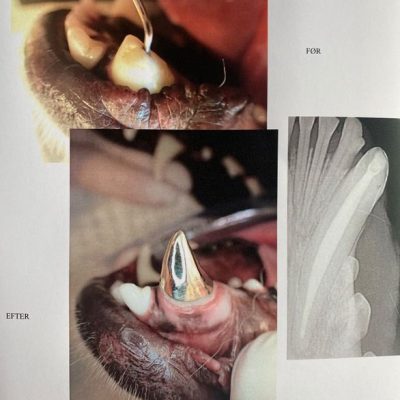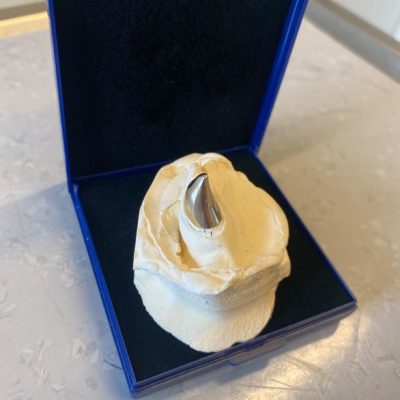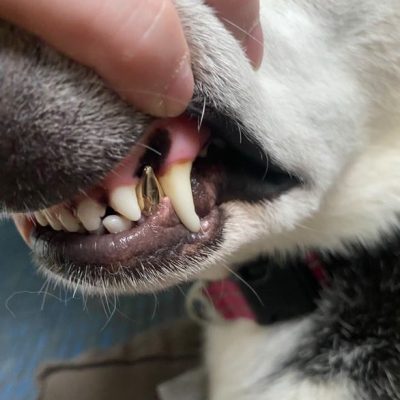In recent years, the topic of dental caps has gained attention, particularly in the dog sports world. Tooth caps are viewed as a protective measure or an aesthetic accessory. We are interested in what the experts say about this.
K9andSports: Do you support the use of dental caps?
The use of tooth caps cannot be recommended. The use of tooth caps significantly increases the risk of fracture of the treated tooth. The mandibular canine comes to lie in the diastema between the third maxillary incisor and the maxillary canine. There is often little space here. If a protective cap is now inserted, it is very easy for the protective cap to come into unphysiological contact with the third maxillary incisor and the maxillary canine. On the one hand, the risk of fracture increases, and on the other hand, the periodontium is subjected to unphysiological stress. In addition, such contacts are extremely unpleasant for the patient. In addition, the risk of periodontitis increases because the protective cap creates a dirt niche in which plaque can adhere particularly well.
K9andSports: So what are the risks associated with using dental caps?
The use of tooth caps restricts the natural tooth elasticity and creates an area in the base of the tooth cap that is subject to a disproportionately high load. In the event of a fracture, it occurs at the base of the tooth cap. A tooth that has been fractured in this way can no longer be functionally preserved.
K9andSports: How should a fractured tooth best be treated?
If a prosthetic restoration really becomes necessary, which is only very rarely necessary, a professional crowning procedure should be carried out. This is usually necessary for teeth that are very deeply fractured so that the canine is no longer functional. If the remaining tooth stump height is less than the height of the third incisor, a proper grip can no longer be achieved. The most important point, however, is the successful treatment of the fractured tooth with root canal treatment!
When crowning, an impression of the tooth stump and jaw is taken after the affected tooth has been prepared. This means that the space in the diastema can be taken into account by the dental technician when designing the crown and unphysiological contact with neighboring teeth can be avoided. However, the fractured tooth cannot be prepared while you are awake. In this context, tooth-lengthening measures should also be avoided, as the risk of fracture increases disproportionately. The aim of a crown is usually to restore serviceability in deeply fractured canini. For this purpose, the height of the crowned canine should reach the height of the 3rd incisive. The prognosis here is rather cautious with regard to tooth preservation. Otherwise, the filling materials currently used in animal dentistry are so convincing that crowning can usually be avoided.
K9andSports: I understand you correctly when I assume that tooth caps should be rejected in principle?
A distinction must be made between prosthetic treatment of a fractured tooth after successful root canal treatment by an animal dentist. This is the “crowning” of a tooth. But there are also metal caps that are glued to the teeth by a lay practitioner. Such metal caps do more harm than good. The dog's tooth is naturally so resilient that the use of metal caps is not necessary. If there are behavioral problems, such as cage biting, you should try to eliminate the cause of the behavior. Materials used in education and training should be designed to avoid excessive tooth wear.
K9andSports: There are still some dogs with such dental caps.
One gets the impression that there is so much interest in dental caps because it “looks cool” to the owners. However, this is a cosmetic argument that does more harm than good!
Dr. Martin Florian Buck started his own practice in Rottenburg an der Laaber in 2005. Dr. Buck offers the complete spectrum of dentistry and jaw surgery, i.e. in addition to maintaining the health of the oral cavity and teeth, also diagnostics and treatment of tooth fractures (tooth preservation using vital pulp therapy, root canal treatment, root tip resection, prosthetics, simple and surgical extractions), periodontal treatments, orthodontic treatments; Jaw surgery (treatment of jaw fractures, removal of tumors, treatment of temporomandibular joint diseases, treatment of salivary gland diseases, gum surgery) as well as the treatment of feline chronic gingivostomatitis.



